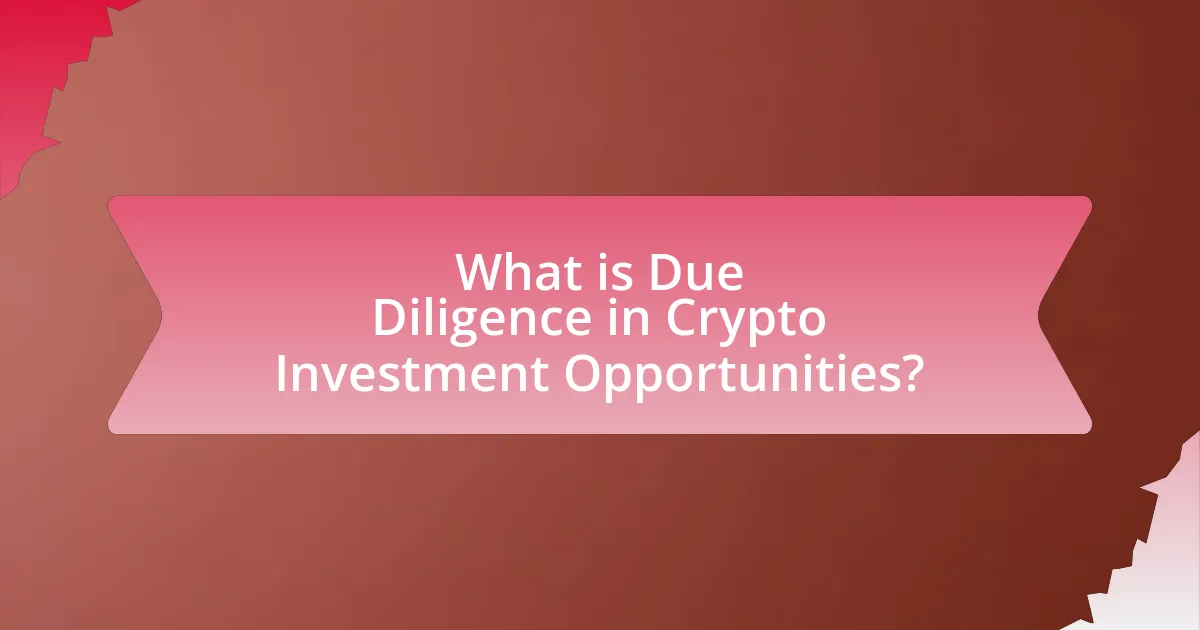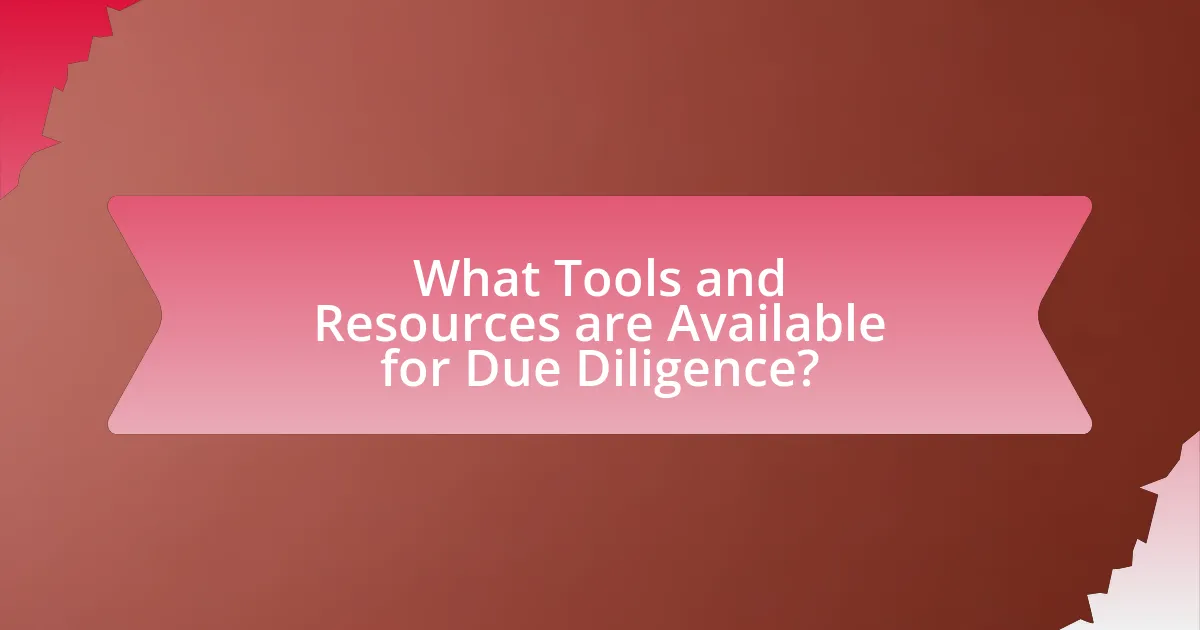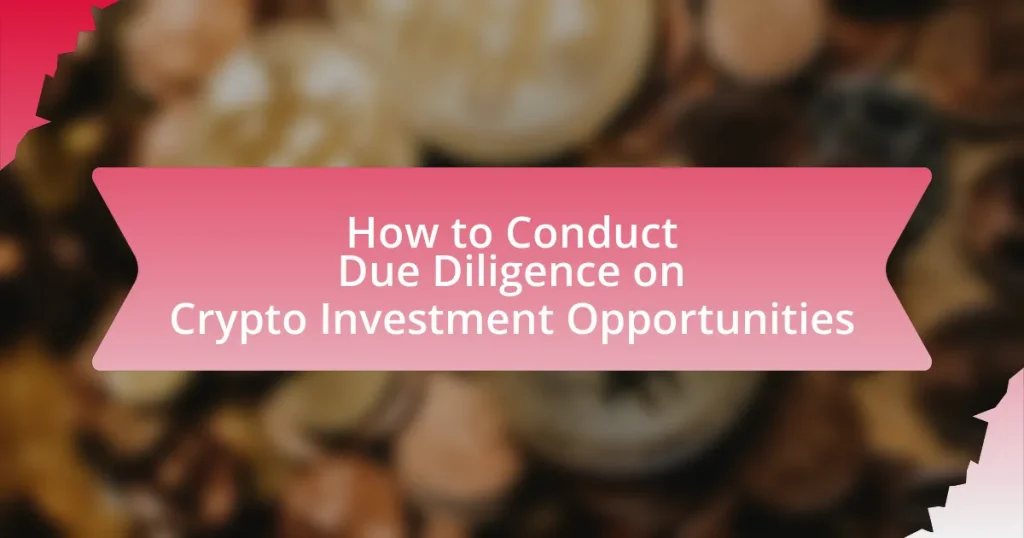Due diligence in crypto investment opportunities is a critical process that involves evaluating various aspects of a cryptocurrency or blockchain project before investing. This article outlines the importance of due diligence, highlighting its role in mitigating risks such as financial loss, regulatory penalties, and reputational damage. Key components of due diligence include assessing the project’s whitepaper, team, tokenomics, regulatory compliance, and community engagement. Additionally, the article discusses financial metrics to analyze, the influence of market trends, and best practices for conducting thorough research, ultimately providing investors with essential tools and strategies for making informed investment decisions in the volatile crypto market.

What is Due Diligence in Crypto Investment Opportunities?
Due diligence in crypto investment opportunities refers to the comprehensive process of evaluating and analyzing a cryptocurrency or blockchain project before making an investment. This process involves assessing various factors such as the project’s technology, team, market potential, regulatory compliance, and financial health. For instance, a study by the Cambridge Centre for Alternative Finance highlights that thorough due diligence can significantly reduce investment risks by identifying potential red flags, such as lack of transparency or unsustainable business models.
Why is Due Diligence Important for Crypto Investments?
Due diligence is important for crypto investments because it helps investors assess the risks and potential rewards associated with a particular cryptocurrency or project. By conducting thorough research, investors can evaluate the credibility of the project, the team behind it, and its market potential. For instance, a study by the Cambridge Centre for Alternative Finance found that 90% of initial coin offerings (ICOs) fail, highlighting the necessity of due diligence to avoid investing in fraudulent or unsustainable projects. This process enables investors to make informed decisions, ultimately protecting their capital and enhancing their chances of success in the volatile crypto market.
What risks are associated with inadequate due diligence?
Inadequate due diligence in crypto investment opportunities poses significant risks, including financial loss, regulatory penalties, and reputational damage. Financial loss occurs when investors fail to identify fraudulent schemes or poorly performing assets, leading to substantial monetary setbacks. For instance, the collapse of the BitConnect platform in 2018 resulted in losses exceeding $1 billion for investors who did not conduct thorough research. Regulatory penalties arise when investors overlook compliance with laws, potentially facing fines or legal action from authorities. The SEC has imposed penalties on firms for failing to adhere to securities regulations in crypto offerings. Lastly, reputational damage can occur if an investor is associated with scams or failed projects, impacting future investment opportunities and partnerships. These risks underscore the necessity of comprehensive due diligence in the volatile crypto market.
How can due diligence mitigate investment risks?
Due diligence mitigates investment risks by thoroughly assessing the financial, operational, and legal aspects of an investment opportunity. This process involves analyzing financial statements, understanding market conditions, and evaluating the management team, which helps identify potential red flags and areas of concern. For instance, a study by the Harvard Business Review found that companies that conduct rigorous due diligence are 30% less likely to experience significant financial losses compared to those that do not. By uncovering hidden liabilities or unrealistic projections, due diligence enables investors to make informed decisions, thereby reducing the likelihood of unexpected losses.
What are the key components of Due Diligence in Crypto?
The key components of Due Diligence in Crypto include assessing the project’s whitepaper, evaluating the team behind the project, analyzing the tokenomics, reviewing regulatory compliance, and examining community engagement. The whitepaper provides essential insights into the project’s goals, technology, and implementation strategy, while the team’s background and experience can indicate the project’s credibility and potential for success. Tokenomics, which encompasses the supply, distribution, and utility of the token, is crucial for understanding its value proposition. Regulatory compliance ensures that the project adheres to legal standards, reducing the risk of future legal issues. Lastly, community engagement reflects the project’s support and can be a predictor of its longevity and success in the market.
What financial metrics should be analyzed?
Key financial metrics to analyze in crypto investment opportunities include market capitalization, trading volume, liquidity, price volatility, and return on investment (ROI). Market capitalization indicates the total value of a cryptocurrency, calculated by multiplying the current price by the total supply. Trading volume reflects the amount of cryptocurrency traded over a specific period, providing insights into market activity and investor interest. Liquidity measures how easily an asset can be bought or sold without affecting its price, which is crucial for assessing potential entry and exit points. Price volatility indicates the degree of price fluctuations over time, helping investors understand risk levels. Finally, ROI assesses the profitability of an investment relative to its cost, allowing for comparison across different assets. Analyzing these metrics provides a comprehensive view of the financial health and potential of a cryptocurrency investment.
How do market trends influence due diligence?
Market trends significantly influence due diligence by shaping the assessment of investment risks and opportunities. When conducting due diligence on crypto investment opportunities, analysts examine market trends to identify potential volatility, regulatory changes, and technological advancements that could impact asset value. For instance, a surge in institutional investment in cryptocurrencies can indicate growing market acceptance, prompting due diligence teams to adjust their evaluations accordingly. Historical data shows that during bullish market trends, asset prices tend to rise, leading to increased scrutiny on valuation metrics and financial health of crypto projects. Conversely, bearish trends often necessitate a more cautious approach, focusing on liquidity and sustainability of the business model. Thus, understanding market trends is essential for making informed investment decisions in the crypto space.
What steps should be taken to conduct Due Diligence?
To conduct due diligence on crypto investment opportunities, follow these steps: First, research the project thoroughly, including its whitepaper, team background, and technology. This involves analyzing the project’s goals, use cases, and the problem it aims to solve. Next, evaluate the team’s credibility by checking their experience and past projects, as a strong team is crucial for success. Additionally, assess the community engagement and support on platforms like social media and forums, as a vibrant community often indicates a healthy project.
Furthermore, review the tokenomics, including supply, distribution, and utility of the token within the ecosystem, to understand its potential value. Investigate any regulatory compliance issues, as legal challenges can impact the project’s viability. Finally, consider the market conditions and competition to gauge the project’s position within the crypto landscape. Each of these steps is essential for making informed investment decisions in the volatile crypto market.
How to evaluate the project’s whitepaper?
To evaluate a project’s whitepaper, analyze its clarity, technical details, and feasibility. A clear whitepaper should articulate the project’s purpose, technology, and roadmap effectively. Technical details must be precise, demonstrating a solid understanding of the underlying technology, such as blockchain protocols or consensus mechanisms. Feasibility can be assessed by examining the project’s market analysis, competitive landscape, and potential for real-world application. Additionally, check for the team’s credentials and past successes, as these factors contribute to the project’s credibility and likelihood of success.
What role does the development team play in due diligence?
The development team plays a critical role in due diligence by providing technical insights and assessments of the project’s feasibility and security. Their expertise helps evaluate the underlying technology, code quality, and potential vulnerabilities of the crypto project. For instance, a thorough code review by the development team can identify flaws that may lead to security breaches, thereby influencing investment decisions. Additionally, their understanding of the project’s architecture and scalability can inform investors about the long-term viability of the investment, ensuring that the technology aligns with market needs and regulatory standards.
How to Analyze the Project’s Fundamentals?
To analyze a project’s fundamentals, evaluate its whitepaper, team credentials, technology, market potential, and community engagement. The whitepaper provides insights into the project’s goals, technology, and use cases, while the team’s background indicates their capability to execute the project. Assessing the technology involves understanding its innovation and scalability. Market potential can be gauged by examining the target audience and competition. Community engagement reflects the project’s support and sustainability. Each of these elements contributes to a comprehensive understanding of the project’s viability and potential for success.
What are the essential elements of a crypto project’s fundamentals?
The essential elements of a crypto project’s fundamentals include the project’s whitepaper, technology, team, use case, market potential, tokenomics, and community engagement. The whitepaper outlines the project’s goals, technology, and implementation strategy, providing a foundational understanding of its purpose. The technology aspect assesses the blockchain’s scalability, security, and innovation. The team’s experience and track record are crucial for credibility and execution capability. The use case evaluates the problem the project aims to solve, while market potential considers the demand and competition within the sector. Tokenomics involves the economic model of the token, including supply, distribution, and incentives. Lastly, community engagement reflects the project’s support and active participation, which can influence its success. Each of these elements contributes to a comprehensive evaluation of a crypto project’s viability and potential for investment.
How to assess the technology behind the cryptocurrency?
To assess the technology behind a cryptocurrency, evaluate its underlying blockchain architecture, consensus mechanism, and scalability features. The blockchain architecture defines how transactions are processed and recorded, while the consensus mechanism, such as Proof of Work or Proof of Stake, determines how network participants agree on the validity of transactions. Scalability features indicate the network’s ability to handle increased transaction loads without compromising performance. For instance, Bitcoin uses a Proof of Work mechanism and has faced scalability issues, leading to slower transaction times during peak usage. In contrast, Ethereum is transitioning to Proof of Stake to improve efficiency and scalability. Analyzing these components provides insight into the cryptocurrency’s potential performance and reliability.
What is the significance of the project’s roadmap?
The significance of the project’s roadmap lies in its ability to outline the strategic direction and milestones of a cryptocurrency project. A well-defined roadmap provides investors with insights into the project’s vision, development timeline, and key objectives, which are essential for assessing its potential for growth and sustainability. For instance, a roadmap that includes specific phases for product development, partnerships, and market expansion can indicate a structured approach to achieving long-term goals. This transparency helps investors make informed decisions, as they can evaluate whether the project’s plans align with their investment criteria and risk tolerance.
How to evaluate the community and market sentiment?
To evaluate community and market sentiment, analyze social media platforms, forums, and news outlets for discussions and trends related to a specific cryptocurrency. Tools like sentiment analysis software can quantify positive, negative, or neutral sentiments expressed in these discussions. For instance, a study by the University of California, Berkeley, found that social media sentiment correlates with market movements, indicating that a surge in positive sentiment often precedes price increases. Additionally, monitoring trading volumes and price fluctuations can provide insights into market sentiment, as increased trading activity typically reflects heightened interest or concern among investors.
What platforms are best for gauging community engagement?
The best platforms for gauging community engagement in the context of crypto investment opportunities are social media platforms like Twitter, Reddit, and Telegram. These platforms provide real-time discussions, sentiment analysis, and community feedback, which are crucial for understanding investor interest and sentiment. For instance, Twitter’s trending topics and hashtags can reveal the popularity of specific projects, while Reddit’s subreddits allow for in-depth discussions and community opinions. Telegram groups often serve as direct communication channels between project teams and their communities, facilitating immediate feedback and engagement.
How does social media influence market perception?
Social media significantly influences market perception by shaping public opinion and consumer behavior in real-time. Platforms like Twitter, Facebook, and Instagram allow users to share experiences and opinions, which can rapidly alter the perceived value of products or services. For instance, a study by the University of Pennsylvania found that 78% of consumers trust online reviews as much as personal recommendations, highlighting the power of social media in establishing credibility. Additionally, trends and discussions on social media can lead to increased visibility and demand for certain assets, particularly in volatile markets like cryptocurrency, where sentiment can drive price fluctuations.

What Tools and Resources are Available for Due Diligence?
Tools and resources available for due diligence in crypto investment opportunities include blockchain analytics platforms, legal and regulatory databases, and financial analysis tools. Blockchain analytics platforms like Chainalysis and Elliptic provide insights into transaction histories and wallet activities, helping investors assess the legitimacy of projects. Legal and regulatory databases, such as LexisNexis, offer information on compliance and legal standings of crypto entities. Financial analysis tools, including CoinMarketCap and Messari, deliver market data and performance metrics, enabling investors to evaluate the financial health of cryptocurrencies. These resources collectively enhance the due diligence process by providing critical data and insights necessary for informed investment decisions.
What online platforms provide crypto analysis tools?
Online platforms that provide crypto analysis tools include CoinMarketCap, TradingView, and Glassnode. CoinMarketCap offers comprehensive market data, including price charts and trading volumes for various cryptocurrencies. TradingView provides advanced charting tools and social networking features for traders to share insights. Glassnode specializes in on-chain data analytics, offering insights into blockchain activity and market trends. These platforms are widely recognized in the cryptocurrency community for their reliability and depth of analysis.
How to use blockchain explorers for due diligence?
To use blockchain explorers for due diligence, access a blockchain explorer specific to the cryptocurrency of interest, such as Etherscan for Ethereum or Blockchair for Bitcoin. These platforms allow users to view transaction histories, wallet balances, and smart contract details, which are essential for assessing the legitimacy and activity of a cryptocurrency project. For instance, by examining the transaction volume and wallet distribution, investors can gauge the level of interest and potential manipulation in the market. Additionally, reviewing the smart contracts can reveal any red flags, such as unusual permissions or lack of transparency. This method is validated by the fact that blockchain explorers provide real-time, immutable data directly from the blockchain, ensuring that the information is accurate and trustworthy.
What role do crypto news outlets play in research?
Crypto news outlets serve as critical sources of information for research in the cryptocurrency sector. They provide timely updates on market trends, regulatory changes, and technological advancements, which are essential for investors conducting due diligence. For instance, a report from CoinDesk highlighted that 70% of cryptocurrency investors rely on news outlets for insights into market movements and potential investment opportunities. This reliance underscores the importance of these outlets in shaping informed investment decisions.
What are the best practices for conducting Due Diligence?
The best practices for conducting due diligence in crypto investment opportunities include thorough research, verification of information, and risk assessment. Investors should start by analyzing the project’s whitepaper, which outlines the technology, use case, and team behind the cryptocurrency. Verification of the team’s credentials and past projects is crucial, as a strong team often indicates a higher likelihood of success. Additionally, investors should assess the project’s market potential, competition, and regulatory compliance to understand the risks involved. According to a report by the Blockchain Research Institute, 70% of crypto projects fail due to lack of proper due diligence, highlighting the importance of these practices.
How to create a checklist for crypto investment evaluation?
To create a checklist for crypto investment evaluation, identify key criteria that assess the viability and potential of a cryptocurrency. Start by including factors such as the project’s whitepaper, which outlines its purpose, technology, and roadmap; the team behind the project, focusing on their experience and credibility; market capitalization, which indicates the project’s size and stability; and community engagement, reflecting user interest and support. Additionally, evaluate the tokenomics, including supply, distribution, and utility of the token, as well as regulatory compliance to ensure the project adheres to legal standards.
These criteria are essential as they provide a structured approach to analyzing investment opportunities in the volatile crypto market, where informed decisions can significantly impact investment outcomes.
What common mistakes should be avoided during due diligence?
Common mistakes to avoid during due diligence include insufficient research, overlooking regulatory compliance, and failing to assess the technology behind the cryptocurrency. Insufficient research can lead to a lack of understanding of the project’s fundamentals, which is critical for informed investment decisions. Overlooking regulatory compliance may result in legal issues, as many cryptocurrencies face scrutiny from regulatory bodies. Additionally, failing to assess the technology can lead to investing in projects with flawed or unproven technology, which can jeopardize the investment’s viability. These mistakes can significantly impact the success of crypto investments, as evidenced by numerous cases where investors faced losses due to inadequate due diligence.
What are the final tips for successful Due Diligence in Crypto Investments?
To successfully conduct due diligence in crypto investments, investors should focus on verifying the project’s fundamentals, including the team’s credentials, technology, and market potential. Researching the development team’s background and experience can reveal their capability to execute the project. Additionally, analyzing the whitepaper for clarity on the project’s goals, technology, and tokenomics is crucial. Investors should also assess community engagement and feedback on platforms like social media and forums, as a strong community often indicates a project’s viability. Furthermore, reviewing regulatory compliance and understanding the legal framework surrounding the investment can mitigate risks. Finally, keeping abreast of market trends and competitor analysis can provide insights into the project’s positioning and future prospects.















